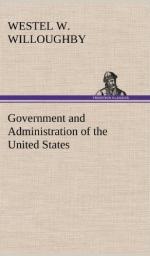_#Elements Tending to Separation and Those Tending to Union.#_—We must remember that this was a union of thirteen previously separate colonies. The facts which had tended to keep them apart had been the difficulty of travel and communication between the colonies, the lack of commercial intercourse, but more than all, their local jealousies. The small States feared the larger; commercial jealousies were very keen. In 1756 Georgia and South Carolina actually came to blows over a dispute as to the navigation of the Savannah river. Other disputes about boundaries were frequent. Colonies with good harbors and seaports desired to keep the benefits of them exclusively to themselves. At that time, too, the people of the thirteen colonies were far more widely separated in their forms of government, their industrial habits and social customs than they now are. On the other hand, the old facts which tended to urge on a common union between them were common race, language, and nationality, many similar political institutions, and, most of all, common interests and a common peril.
_#The Purposes of the Confederation.#_—The purposes of this Confederation are best stated by giving Article III of the Articles:
“The said States hereby severally enter into a firm league of friendship with each other for their common defense and security of their liberties and their mutual and general welfare, binding themselves to assist each other against all force offered to or attacks made upon them, or any of them, on account of religion, sovereignty, trade, or any other pretext whatever.”
_#Scheme of Government under the Articles of Confederation.#_—The Articles of Confederation established a framework of government for the confederated colonies, which government was to control those matters that experience had shown could be executed only by united action. As a scheme of government it was no better than a makeshift. It was an effort to form a federal power without diminishing the powers of the States—an effort “to pare off slices of state government without diminishing the loaf.” That such a union could be perpetual, as the scheme professed, was impossible.
Under these Articles of Confederation the sole functions of the federal authority, legislative, executive, and judicial, were vested in a Continental Congress, consisting of a single house of delegates, who voted by States, and were appointed annually in such a manner as the respective States directed. Each State was entitled to not less than two nor more than seven delegates, a majority of whom decided the vote of the State in question. The executive functions were largely performed by a Committee of States, which was empowered to sit during recesses. For all important measures the vote of every State was required. The vote of all thirteen was required for an amendment.
_#Defects of the Articles of Confederation.#_—In this scheme of union there were many fatal defects. The principal of these defects were—




